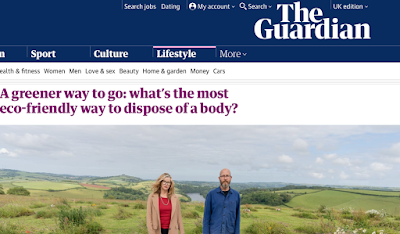I was delighted to see this article in today’s Guardian, not least because it prompted me to visit my archives, where I found this piece I wrote about resomation for Humanitie Magazine in 2010.
When a body is buried in shallow soil, one of the principal biochemical aspects of natural decomposition is alkaline hydrolysis carried out by soil bacteria. Sandy Sullivan was the European president of a US corporation that used Alkaline Hydrolysis in other processes, and saw it could be used for the disposal of human remains.
Three years ago, he set up Resomation Ltd in Glasgow, using an accelerated version of the same chemistry to do in three hours what it takes nature years to achieve. The benefits are considerable.
Resomation uses 7 times less fossil fuel than cremation, and its carbon footprint is 4 times lower. It also avoids the production of harmful mercury emissions from teeth amalgam.
When cremation was introduced in 1874, the global population was only 1.6 billion. Today, it’s 6.5 billion, and the toxins released during cremation are recognised as a growing environmental problem.
As the world’s population continues to grow, resomation looks like the smartest choice for the future, so it’s no surprise that Sullivan’s globally patented process won the John Logie Baird Award for Innovation in 2009 and the Observer Big Idea Ethical Award in 2010.
Perhaps because Time Magazine and the New York Times voted it one of the top ideas of 2009, the resomation process is now legal in 6 states of the USA, and the company has just installed its first working system in Tampa, Florida.
Here In the UK, the Scottish government recently undertook a detailed review of the funeral industry and recommended that death certification should be ‘future proofed’ to cover technologies like resomation.
Legislation is likely to be approved next year, after which Sullivan is confident that resomation will be welcomed around the world as individuals choose it as a last way to express their environmental awareness and concern*.
“The disposition of a body is a very emotional choice,” says Sullivan. “It’s an area of life where change is understandably slow. We need to explain resomation clearly, and demonstrate the environmental benefits. When I began, most people said it would be impossible. I’ve had moments of doubt, but we are now very close to changing history. It is easily the most rewarding role I have ever taken on. My aim is to ensure that resomation is available around the world, and as soon as we get legislative cover in Scotland we’ll be making our first installation here. It’s a very exciting time.”
*This article was written in November 2010: as yet, (July 2019) the Scottish Government has made no decision: I can only hope that they will look again, and do so soon.

0 Comments Leave a comment